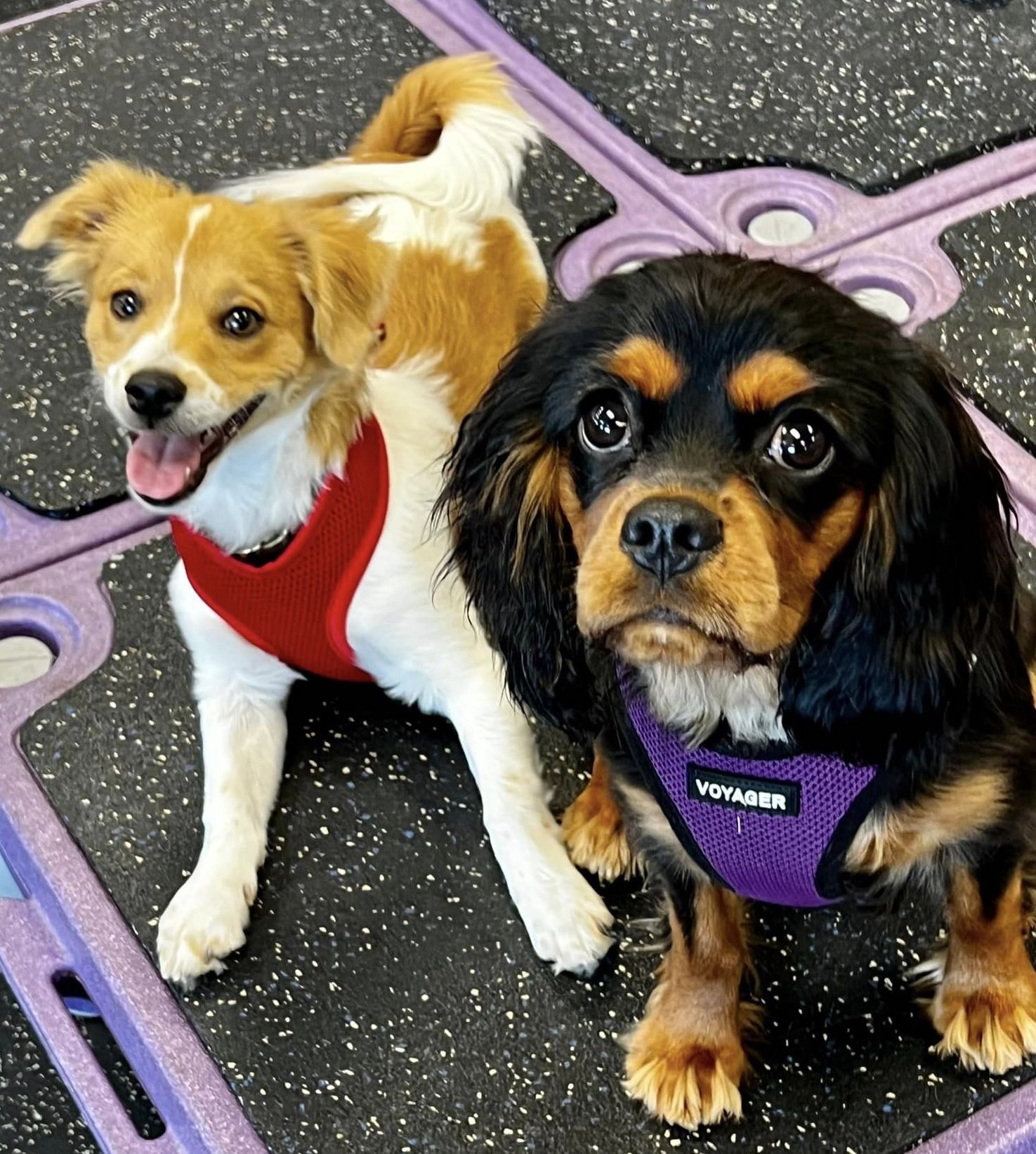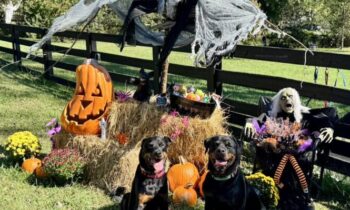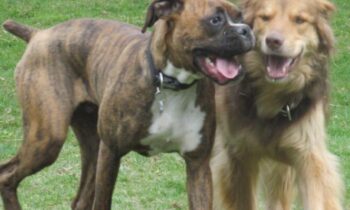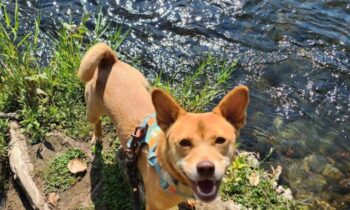

Last week, a trainer and instructor from the United Kingdom shared her experience and opinions about how to find a good puppy class for your pup. This week, a trainer and instructor from the United States shares her belief that puppy class is the most important class in the life of any dog.
Here is what she wants puppy guardians to know:
Ann Jorgensen (Alaska) Puppy class is the most important class in the life of any dog, any breed—even puppies in shelter.
Why? Because it teaches puppies and people what appropriate play looks like. The class should allow the pup to learn bite inhibition with puppies and people through appropriate play. It also gets their people on the right track for bonding, handling, potty training, diet, veterinary handling, medical emergencies, puppy proofing, items that are dangerous or toxic, amounts of exercise and mental stimulation needed and appropriate for breed/mix breed type, and spotting potential issues that may need to be addressed at a higher level; for example, separation anxiety or breed tendencies that may be appropriate, but the guardian may deem inappropriate.
When I speak of puppy class, I’m talking about puppies aged eight weeks to 16 weeks. I term it Puppy Preschool. I started teaching this class in 2005 through a veterinary clinic and learned from Karen Overall, Ian Dunbar, and my mentor, Catherine Ulibarri.
This age group is very important because most dogs are still in their “critical period.” I called it “the golden hour of learning.” Back then was the era when CPDT and CAAB were the only certifying agencies and the dog-training world was not as ugly and fractured as it is now. I learned by reading “white papers” and professional books, and by talking with my mentor, a college professor and a Certified Applied Animal Behaviorist (CAAB). I also had finished my masters in animal behavior and had been teaching at all grade levels, plus I grew up in a hunting-dog family. I also mentored students myself (something that I wish were still more important than a two-hour test to add initials after your name).

Photo by Sarah Richardson
I digress, but here is what I would look for in a puppy class:
1) First, that the instructor is advanced and has veterinary and behavior experience. If this is a group of trainers, it should be their most experienced person. I couldn’t care less about the initials behind their names (with the exception of advanced degrees and licensed vet techs with behavior endorsements) or what association they bow down to. I would ask them (a) how they learned to teach, (b) what they teach in the class, and (c) how they handle puppies with abnormal behaviors.
2) Where is the class taught? How is the area disinfected? How many puppies are in the class? How is the class structured? Do they ensure a balanced mix of breeds? Do they confirm vaccinations and parasite treatment/prevention? Are they transparent if a puppy in the class breaks with an illness?
3) How much of the class is “puppy play time” and how do they ensure that puppies are appropriate in their play?
4) Do they have a simple syllabus of the topics for each week (typically six weeks)?
5) What do they do to help a puppy that might be shy or overbearing?
The answers that I look for to the above questions:
The class is taught in a confined area on a floor that can be thoroughly disinfected. The area should be small enough that six puppies can play without building up enough speed to injure themselves if it is on hard flooring. The lobby of a vet clinic is great.
All guardians must supply vaccination and parasite treatment/prevention verification.
In a 50-minute class, I provided two play sessions, ten minutes each at the beginning and end of class. This is critical because these are when I identified issues with appropriate play, the beginnings of behavior issues, and even veterinary issues. (I usually found a puppy in every other class that needed additional training and occasionally behavior modification. Less often, I found signs of medical issues, like retained puppy teeth, urinary infections, and once a major cardiac issue.)
While puppy play time might seem unstructured, it definitely is not. I was often correcting issues (I do not mean through punishment). Most often, it was fearful dogs or over-exuberant dogs. It’s far too much to put in here, but the instructor should be watching the pups very carefully, sometimes stepping in to give people a little break. There should be no rough handling by the instructor, like scuffing, scolding, rolling, etc.
I usually also gave homework, like doing a treat buffet to find what each pup valued most. We kept the top treat for the emergency recall. The second favorite treat was for training new tasks. I also told the guardians to get rid of the food bowl and to use food for treating throughout the day and for putting in interactive feeders. Then we moved on to ‘pass the puppy’ on the floor. This continued through all the classes and I’d have an open question period. One week a vet came, talked about health, and did “fake exams” with lots of treats, followed by emergency recalls that then were practiced in play groups.
Another week, I talked about fitting collars, harnesses, and leashes. Then we did a “by me” where pups followed their people, often leash dragging. The pups learned “place” through the whole class by resting on a towel or blanket. Depending on the class, I would add “touch,” just to the hand, and often the start of “leave it” for the baby sharks, just the hand.
This might sound like a lot or a little, depending on who is reading it. It was all done with purpose and carried through the whole class. I’d tell my mentors it was like conducting an orchestra.
If you notice, there isn’t any mention of what is typically termed obedience training—sit, down, heel, etc. For me, this was taught in Puppy Kindergarten—typically puppies over 16 weeks and up to six to eight months, depending on the dog. A good trainer can teach most basic commands in a hour.
What should get a puppy guardian tucking tail and running:
No qualifications provided for teaching the class, when that information should be readily available, giving references (both from former students and from veterinary professionals) as well as verifying credentials
Unsanitary conditions in the facility; if the teaching area contains flooring like rubber, grass, or dirt, that is a red flag
Not answering how and what they use to sanitize the area before each class
Not asking for current proof of vaccinations, parasite treatment, and how they will disclose if there has been an illness in the facility
Putting anything metal around the neck, like choke chains and prong collars, or shock collars (punishment-based). Tugging puppies around by a leash. Not providing structured play time.
Not having a syllabus with expectations and giving homework
And not admitting to issues they may not have an answer for and consulting a more experienced trainer or referring you to one
I have always said if a person takes their dog to only one class, Puppy Preschool should be the one. Having been on the shelter side of animal welfare, I never had an adopter ask for a dog that knew sit, down, etc. It was, Are they friendly with people? Are they friendly with other dogs? There is a white paper that showed if a dog made contact with a potential adopter, that trumped all … obedience, tricks, toys. What gets a dog surrendered? Failure to potty train, destructive behavior, aggressive behavior, rude leash behavior, even stranger danger. And a big one is boredom issues. These are often good homes that just didn’t have the education for themselves or their pup.
The class should feel fun and educational. The instructor should be educating the class on everything they are doing and should never single out anyone.
Instructors should also provide ADA accommodations. I had several service pups come though my classes.
A few things about my instruction style. I believe all pups should start off leash. A leash should be a back-up, not the primary reason a dog stays by their person. I also don’t believe in food bowls. It’s been shown that feral dogs are scavengers. They spend most of their day looking for food, not sitting in a crate for eight hours then exiting to a heaping bowl of kibble and maybe a short walk or time by themselves in a yard.
The other thing about puppy class is that if it’s run properly, it increases the dogs’ immunity through passive exposure, as published by Dr. Overall. I prefer to teach out of a vet clinic or in a shelter classroom for many reasons, including those mentioned above. Those with private facilities should have an area dedicated only to puppies.
Now you have three weeks of information on the topic of puppy classes. If you’re a new puppy guardian or, better yet, if you’re expecting to be a new puppy guardian when you bring that new pup home, we encourage you to consider how important it is to do your own due-diligence on choosing a good puppy class—the right puppy class—for your new family member. Then take the class you’ve decided on and enjoy it with your puppy!



